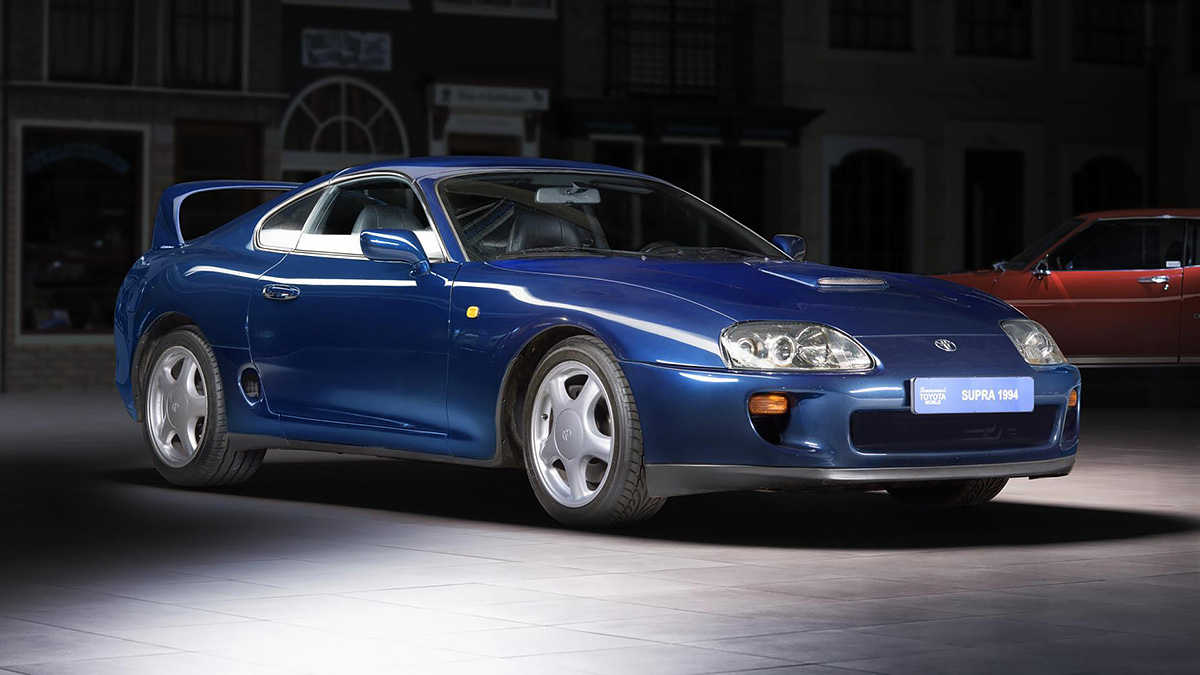
Just why is everyone getting so lathered up about the new Supra? Because of the old one. All hail the A80
The A80 arrived at a time when the Japanese sports-car had transformed itself from a bit of a joke to something that could take on the world. The exotic NSX and delightful MX-5 led the wave, but there was the tech-heavy Mitsubishi 3000GTO, the brutal Nissan 300ZX, the gorgeous and fast twin-turbo third-gen RX-7… and then the new Supra. Anything less than total awesomeness would have brought dishonour to the house of Toyota.
Awesomeness was delivered. Click through to see why…
1. That spoiler
Let’s get it out of the way. In 1993 a wing like that was properly raunchy. The fact that it harmonised so well with the whole car’s curvy nature just made it even better. Together with a motorised active front air dam, it actually produced downforce. And heck, the Supra’s engine walked it like the wing talked it.
2. It broke the gentlemen's agreement
For many years the Japanese industry agreed among itself to limit output to 280bhp. In the home market the Supra went along with this, from its 3.0-litre twin-turbo 24-valve straight-six – a configuration the new car adopts too.
But for export markets it was retuned and had different turbos, for 326bhp. This was monster – more than the M3 of the day, nearly as much as the newly-launched 911 Turbo 3.6.
It was a clever engine too, with sequential turbos, one of them operating at low revs, then the second was spun-up but didn’t actually charge the cylinders. Finally the dam to second was opened, and propelled by the both of them you flew. The 0-97kph is 4.9 seconds. Trust us, a quarter-century ago that was properly something.
Remember, today’s Supra is barely more powerful. Oh and the mighty 2JZ-GTE wasn’t overstressed. Tuners can take the power into four figures.
3. It was light with it
This was no sledgehammer hot-rod. Toyota made diligent efforts to cut weight, and ended up with a better power-to-weight ratio than the Ferrari 358.
They chose aluminium for the bonnet, suspension upper arms, bumper supports and more. It had a single exhaust because a twin one gave no more power. The steering column didn’t telescope-adjust. Some of the details seem hilariously obsessive: a magnesium steering-wheel armature, and hollow carpet fibres. Those savings helped offset the weight of twin airbags, electric seats and other lavish kit.
The turbo version (we didn’t get the JDM nat-asp version here) was about 1,585kg.
4. Sophisticated, but crazy too
It had traction control, in an era when a BMW E36 M3 didn’t. It also had mighty effective ABS brakes and a limited-slip diff. Those electronics had their limits, mind. I remember being on the elevated section of the Westway coming out of London one wet night (this was before the 40mph/64kph limit, and way before the average-speed cams that now enforce it). I floored it in third, the turbos caught on and suddenly the rear wheels were spinning frantically. But it kept going straight.
The Supra’s top speed was limited to 250kph, but they say it would otherwise nudge 290kph.
5. It handled
The Supra steered sharply and cornered with real conviction. That night in late-1993 I was delivering the car to Roger Bell, a superb road-tester, writer and driver – he’d given Andy Rouse some hurry-up when they were team-mates in works touring cars. Roger took the Supra to England’s best roads with a then-new six-cylinder M3, and came back saying the Supra was brilliantly sorted, and the more involving and faster of the pair.
You could handle it too: one of the Supra’s few extras in the UK was £260 for a course at the John Watson Performance Driving School at Silverstone.
6. More drama inside
The A80’s dash traced an extravagant monoposto sweep around the driver, leaving the passenger completely out of the picture. A huge tacho took pole position, and to the left of it a speedo whose digits strutted all the way to 180mph and 300km/h. In the manner of the time, it was pebble-dashed with buttons – the climate-control alone had fully a dozen plus two twist-knobs. The fact it was so well-equipped helped up the button-ante.
7. Rarity built the myth
The whole A80 series had a good run, from 1993-2001 in Japan. But in the UK it sold for just three years and 600 copies in total. Coupe sales were falling, and the rising Yen didn’t help so Toyota was culling its sprawling range. Emissions regs pushed it out of the US a couple of years later.
8. It's been immortalised as a movie car hero
It runs a different tack from other movie hero cars, but the inexplicable, supersonic stardom of the Fast and Furious franchise means the MkIV Supra remains one of the most recognisable cars on our planet. The one pictured above, which the late Paul Walker drove in the first FF film, sold for many hundreds of thousands of dollars a few years back.
And considering the franchise shows no signs of slowing down (or even making sense), the next generation of petrolheads will now look to the new Supra to lust after. Here’s what they’ll get…

